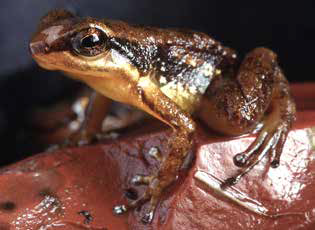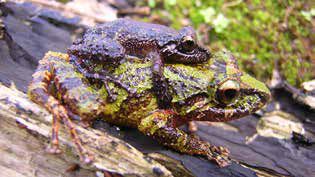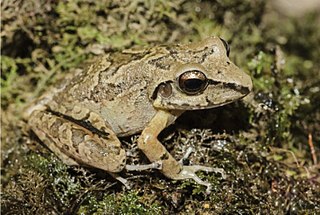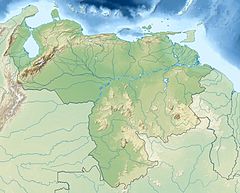
Anomaloglossus breweri is a species of frogs in the family Aromobatidae. It is only known from its type locality, Aprada-tepui in the Bolívar state of southeastern Venezuela. This species was discovered by scientists exploring the inaccessible and remote region of Aprada-tepui. It is a fast-moving frog that lives along creeks and in quiet pools along small streams along the slopes near the cave. The frog is named for Charles Brewer-Carías who collected the type series.
Atelopus vogli is an extinct species of harlequin frog in the family Bufonidae. It was endemic to Venezuela. It is known from collections in two localities: its type locality, Las Peñas near Hacienda la Trinidad in Aragua, and Montalbán in Carabobo. It was first described as subspecies of Atelopus cruciger. The specific name vogli honours Cornelius Vogl, German priest who was a missionary in Venezuela in 1925–1959. Common name Vogl's harlequin toad has been coined for it.
"Cochranella" riveroi is a species of frog in the family Centrolenidae. It is endemic to Cerro Aracamuni, Venezuela. The generic placement of this species within the subfamily Centroleninae is uncertain.

Anomaloglossus parkerae is a species of frog in the family Aromobatidae. As currently known, it is endemic to Venezuela and is only known from near its type locality in the La Escalera, the Bolívar state, Venezuela, near the Guyanese border. However, its range is expected to extend southward to the Gran Sabana as well as into the adjacent Guyana. The specific name parkerae honors Dr. Nancy Parker, undergraduate adviser of one of the scientists who described the species.

Anomaloglossus praderioi is a species of frog in the family Aromobatidae. It is found in the Pantepui region of southeastern Venezuela and western Guyana. More specifically, this frog is known from Mount Roraima, Sierra de Lema in Venezuela, and Maringma-tepui in Guyana. Its actual range is probably wider and might reach into northern Brazil.

Anomaloglossus triunfo is a species of frog in the family Aromobatidae. It is endemic to Venezuela and is only known from the summit and slopes of Cerro Santa Rosa, on the northwestern slopes of Sierra de Lema, Bolívar state. It might be synonym of Anomaloglossus parkerae. The specific name triunfo is the name of the camp site that was used as the base for herpetological surveys by one of the scientists who described the species.
Allobates undulatus is a species of frog in the family Aromobatidae. It is endemic to Venezuela where it is only known from its type locality, Cerro Yutajé, in the Amazonas state. The specific name undulatus refers to the characteristic wavy-edged dorsal marking of this species.

Anomaloglossus wothuja is a species of frog in the family Aromobatidae. It is endemic to Venezuela and is only known from its type locality, the base of Cerro Sipapo, in the Amazonas state. It appears to be endemic to the Cerro Cuao massif but might occur more widely in similar granitic areas.

Scarthyla vigilans is a species of frog in the family Hylidae. It is found in northern Colombia, northern Venezuela, and Trinidad. Although generic allocation of this species has been controversial, molecular data have now confirmed its close relationship with Scarthyla goinorum and placement in that genus. Indeed, adults are very similar to Scarthyla goinorum; however, the male advertisement call and tadpoles are clearly distinct.
Ceuthomantis cavernibardus is a species of frog in the family Craugastoridae. It is found in the Sierra Tapirapecó in the Amazonas state of Venezuela as well as in the adjacent Amazonas state of Brazil. The specific name cavernibardus is derived from the Latin caverna for "cave" and bardus for "singer". It refers to the caves commonly used by calling males.

Pristimantis riveroi is a species of frog in the family Strabomantidae. It is endemic to Venezuela and only known from the region of the type locality in the Serranía del Litoral in the state of Aragua. The specific name riveroi honours Juan A. Rivero, a Puerto Rican herpetologist. Accordingly, common name Rivero's ground frog has been proposed for it.
Pristimantis variabilis is a species of frog in the family Strabomantidae. It is found in the lowland Amazon rainforest and Andean slopes in southern Colombia, eastern Ecuador, eastern Peru, and western Brazil. The specific name variabilis refers to the variable dorsal coloration of this frog. Common name variable robber frog has been proposed for it.

Pristimantis vilarsi, also known as the Rio Uaupes robber frog, is a species of frog in the family Strabomantidae. It is found in the upper Amazon basin in Brazil, Peru, Colombia, and Venezuela.

Stefania breweri, also known as Brewer's carrying frog, is a species of frog in the family Hemiphractidae. It is endemic to Cerro Autana, Venezuela, and only known from a single specimen (holotype). It was named for Venezuelan explorer Charles Brewer-Carías.
Stefania riae is a species of frog in the family Hemiphractidae. This species is only known from Cerro Sarisariñama, a tepui in the Bolívar State, Venezuela.
Cerro Aracamuni is a granitic tepui in Amazonas state, Venezuela. Part of the Neblina–Aracamuni Massif, it lies north of Cerro Avispa and the vast complex of Cerro de la Neblina. Cerro Aracamuni and Cerro Avispa share a common slope area; they have a combined summit area of 238 km2 (92 sq mi) and an estimated combined slope area of 658 km2 (254 sq mi). Both of these cerro-plateaus have a maximum elevation of around 1,600 metres (5,200 ft).

Pristimantis jamescameroni is a species of frog belonging to the family Strabomantidae. It is an orange-brown coloured small frog reported so far only from the Aprada-tepui, a table-top mountain in Bolívar state, Venezuela. It was discovered in June 2012 and formally described in October 2013 by Belgian biologist Philippe J. R. Kok at the Royal Belgian Institute of Natural Sciences and Vrije Universiteit Brussel. The species was named after the Hollywood filmmaker James Cameron, in recognition of his efforts in environmental awareness, and in addition to his public promotion of veganism as a way of animal conservation. Due to its restricted occurrence, the species could be classified as "endangered" according to the criteria of the IUCN Red List of Threatened Species.

Ceuthomantis is a small genus of craugastorid frogs, also treated as comprising their own monogeneric family Ceuthomantidae. They are found in the southern and eastern parts of the Guiana Highlands in Venezuela, Guyana, and Brazil. The generic name is derived from the Greek noun mantis, which means treefrog, and adjective keuthos, which means hidden, in allusion to the hidden existence of this genus in the tepuis of the Guiana Shield.
Ceuthomantis duellmani is a species of frog in the family Ceuthomantidae. It is endemic to the Sarisariñama tepui, Bolívar state, in the southeastern Venezuela. It is named in honour of William Edward Duellman, herpetologist from the University of Kansas.
The tepui tree frog is a frog in the family Hylidae, endemic to Brazil and Venezuela. Scientists have seen it between 420 and 1800 meters above sea level.












